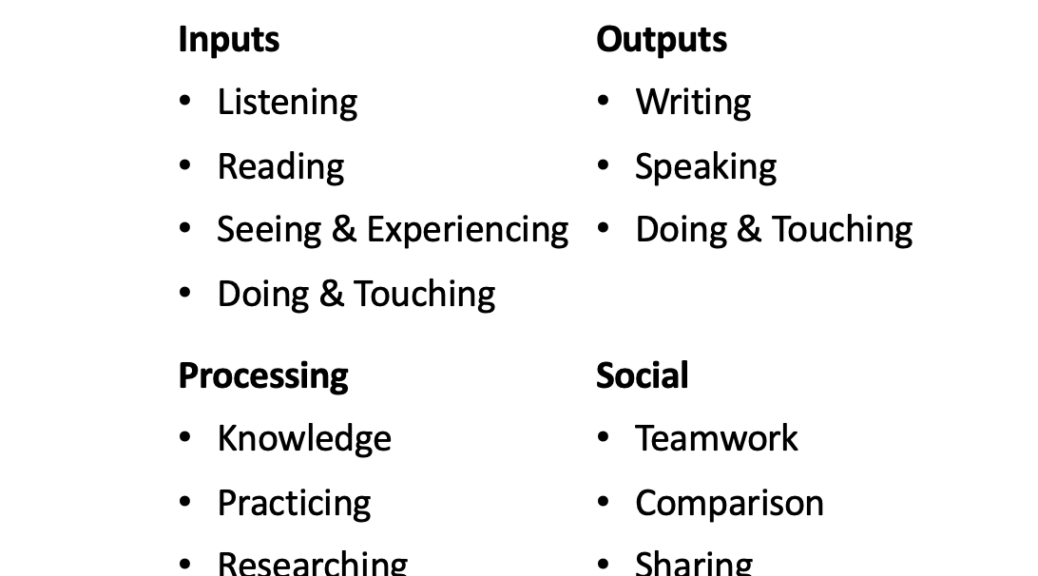As you dig deeper into artificial intelligence it helps to have an intelligence model to provide a framework for discussion. This post follows on from New AI’s – Seven Intelligence’s but really is to set the scene for my examples of accelerated intelligence which will come later.
If you’ve made it this far I welcome you to the theory and I genuinely feel shocked that there are people other than me who find this interesting!
This is the concept: The art of adding intelligence to systems that will speed up the acquisition of intelligence to the user. To do this we need an intelligence model that helps us define what solutions to solve.
Let’s dig in and…
Define The Intelligence Model
- Inputs
- Listening
- Reading
- Seeing-Experiencing
- Doing-Touching
- Outputs
- Writing
- Speaking
- Doing-Touching
- Processing
- Knowledge
- Practicing
- Researching
- Social
- Teamwork
- Comparison
- Sharing
Let’s go through these in detail
Inputs
As humans, we’re a little bit limited in our ability to take in new inputs and share what we know. It’s important to have an understanding of these as they form the core of what will become knowledge that we can build intelligence from.
Listening includes what information have we heard – an important way of gaining new knowledge. The questions have we been asked determined where others have knowledge gaps or where they are testing our existing knowledge.
Reading includes both technical writing through infographics and pictures.
Seeing / Experiencing is one of the most powerful inputs as seeing something happen triggers emotions that are powerful for memory.
For example, a patient recovering after taking a drug – seeing that patient go from sick to healthy will be more memorable than just reading about it. Seeing and experiencing would also include identifying body language and emotion.
Doing / Touching is an interesting category as I see it both an input and an output. As we interact with the world we are taking feedback on the consequences of our actions. Interacting with a system will provide inputs that we’ll need to take into account.
Outputs
And on the other outputs of our intelligence model we have:
Speaking ranging from formal (proposal presentations) to business (running a meeting) to less formal (phone call or social conversations.)
Various voice tools are used to convey information such as timbre, pitch, pace, volume, and inflection.
Writing ranging from very formal (proposals, contracts, statements of work) to business (emails, presentations) and informal (text messages.) Writing includes anything that can be read so includes text, pictures, and variations in between.
Doing is how we interact with the world. I’ll include free-hand drawing here and other forms of live activity that provide people an experience as we are actively engaged in the process. The way we express our body language can be a big factor in human communication.
Processing
In between our inputs and outputs various processing and storage occur. While processing isn’t experienced by outsiders as intelligence it’s critical to how we improve our outputs.
Knowledge is what we know. This can be models of the world or an understanding of a problem. We can start to categorise with lists of information or links between entities. It’s also important to understand what we don’t know yet.
Practicing allows us to refine and improve the outputs and inputs. This helps to build a model of the world and what-if scenarios.
Researching admits that there are gaps in our knowledge that can be improved. The research phase is an admission of importance to fill that lack of understanding through other inputs or processing.
Social
And finally, we have to recognise that intelligence comes through interacting with the world. It generally involves others and our ability to be social. As we enhance those abilities we can also accelerate a team’s intelligence.
Teamwork is the structure of a team and the role we play within that team. Defining positive and negative behaviour within the team allows us to build a model of shared success.
Comparison of the team provides a picture of what good and bad looks like between individuals and the roles they are playing. We can test hypotheses out more quickly than any individual could by comparing different behaviours.
Sharing underpins a team’s success. A team unwilling to share is unwilling to work together. We are all in need of being taught how to share effectively.
Intelligence Model Summary
Working backward through these points:
- Teams help to accelerate knowledge quicker than an individual is possible.
- The quality of our processing helps us to better utilise inputs and deliver outputs and also derive knowledge.
- The outputs show our intelligence
- And the inputs add knowledge (other than that derived through processing.)

